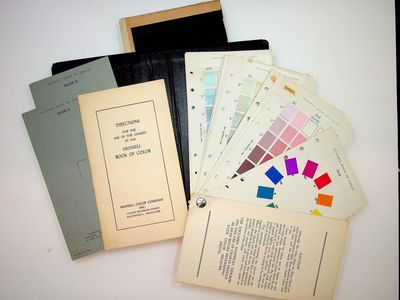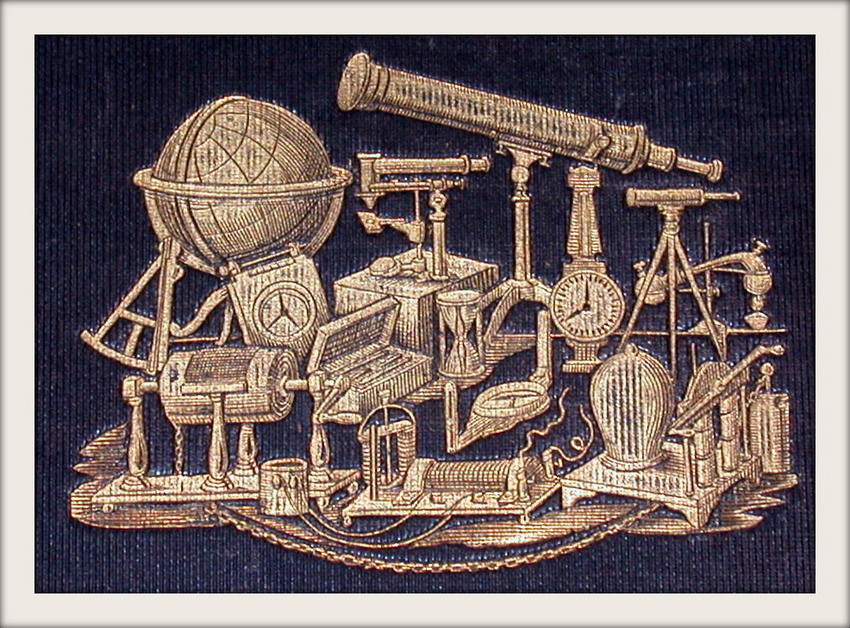Spiral bound
1943 · Baltimore, Maryland
by Munsell, A. H. [Albert]
Baltimore, Maryland: Munsell Color Company Inc, 1943. Spiral bound. Very Good. Not paginated or numbered. 7 1/4 x 4 1/4 inches. Pebbled cloth binding with single post connecting color charts to the binding. Contains 22 color charts, plus three Mask cards (A, B, C) and an instruction booklet. Each color chart has a selection of color chips carefully arranged. Most of the color charts retain their original envelopes "designed to protect the chips from dirt or abrasion". NOTE: The first color chart looks like it may have been added from another Munsell book since it's title is cut off and the overall card size is smaller. Spiral bound. The Munsell Color Company continually evolved this system, with updates occurring regularly. This format (which we believe is called the "Pocket edition") by 1965 was substantially enlarged with 41 color plates. While the mask cards in this example are copyrighted 1929, and individual color charts are copyrighted 1929, a section in the rear of the Directions pamphlet references additional scientific papers. These papers are dated as late as 1943.
"In colorimetry, the Munsell color system is a color space that specifies colors based on three properties of color: hue (basic color), value (lightness), and chroma (color intensity). It was created by Albert H. Munsell in the first decade of the 20th century and adopted by the United States Department of Agriculture (USDA) as the official color system for soil research in the 1930s.
Several earlier color order systems had placed colors into a three-dimensional color solid of one form or another, but Munsell was the first to separate hue, value, and chroma into perceptually uniform and independent dimensions, and he was the first to illustrate the colors systematically in three-dimensional space. Munsell's system, particularly the later renotations, is based on rigorous measurements of human subjects' visual responses to color, putting it on a firm experimental scientific basis. Because of this basis in human visual perception, Munsell's system has outlasted its contemporary color models, and though it has been superseded for some uses by models such as CIELAB (L*a*b*) and CIECAM02, it is still in wide use today." (Wikipedia). (Inventory #: 29513)
"In colorimetry, the Munsell color system is a color space that specifies colors based on three properties of color: hue (basic color), value (lightness), and chroma (color intensity). It was created by Albert H. Munsell in the first decade of the 20th century and adopted by the United States Department of Agriculture (USDA) as the official color system for soil research in the 1930s.
Several earlier color order systems had placed colors into a three-dimensional color solid of one form or another, but Munsell was the first to separate hue, value, and chroma into perceptually uniform and independent dimensions, and he was the first to illustrate the colors systematically in three-dimensional space. Munsell's system, particularly the later renotations, is based on rigorous measurements of human subjects' visual responses to color, putting it on a firm experimental scientific basis. Because of this basis in human visual perception, Munsell's system has outlasted its contemporary color models, and though it has been superseded for some uses by models such as CIELAB (L*a*b*) and CIECAM02, it is still in wide use today." (Wikipedia). (Inventory #: 29513)




![[typewriter carbon] 1927 Constitution of the Massachusetts Institute of Technology Flying Club](https://d3525k1ryd2155.cloudfront.net/h/656/816/1675816656.0.m.jpg)
